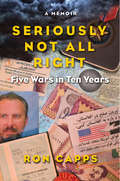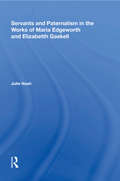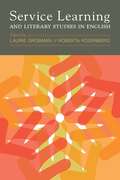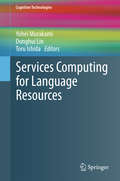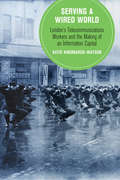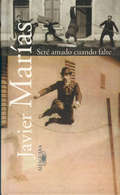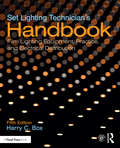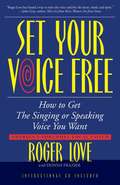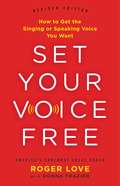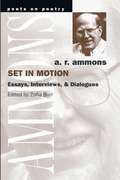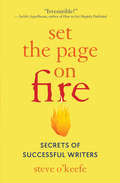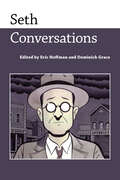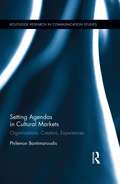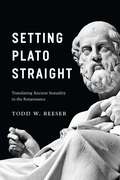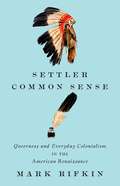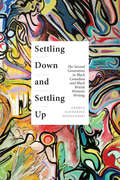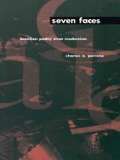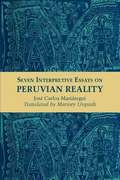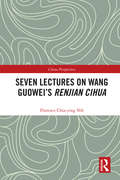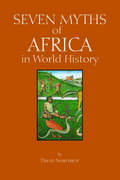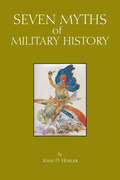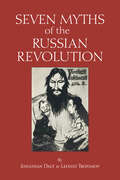- Table View
- List View
Seriously Not All Right: Five Wars in Ten Years
by Ron CappsFor more than a decade, Ron Capps, serving as both a senior military intelligence officer and as a Foreign Service officer for the U.S. Department of State, was witness to war crimes, ethnic cleansing, and genocide. From government atrocities in Kosovo, to the brutal cruelties perpetrated in several conflicts in central Africa, the wars in both Aghanistan and Iraq, and culminating in genocide in Darfur, Ron acted as an intelligence collector and reporter but was diplomatically restrained from taking preventative action in these conflicts. The cumulative effect of these experiences, combined with the helplessness of his role as an observer, propelled him into a deep depression and a long bout with PTSD, which nearly caused him to take his own life. Seriously Not All Right is a memoir that provides a unique perspective of a professional military officer and diplomat who suffered (and continues to suffer) from PTSD. His story, and that of his recovery and his newfound role as founder and teacher of the Veterans Writing Project, is an inspiration and a sobering reminder of the cost of all wars, particularly those that appeared in the media and to the general public as merely sidelines in the unfolding drama of world events.
Servants and Paternalism in the Works of Maria Edgeworth and Elizabeth Gaskell (The\nineteenth Century Ser.)
by Julie NashWriting during periods of dramatic social change, Maria Edgeworth and Elizabeth Gaskell were both attracted to the idea of radical societal transformation at the same time that their writings express nostalgia for a traditional, paternalistic ruling class. The author shows how this tension is played out especially through the characters of servants in short fiction and novels such as Edgeworth's Castle Rackrent, Belinda, and Helen and Gaskell's North and South and Cranford. Servant characters, the author contends, enable these writers to give voice to the contradictions inherent in the popular paternalistic philosophy of their times because the situation of domestic servitude itself embodies such inconsistencies. Servants, whose labor was essential to the economic and social function of eighteenth- and nineteenth-century British society, made up the largest category of workers in England by the nineteenth century and yet were expected to be socially invisible. At the same time, they lived in the same houses as their masters and mistresses and were privy to the most intimate details of their lives. Both Edgeworth and Gaskell created servant characters who challenge the social hierarchy, thus exposing the potential for dehumanization and corruption inherent in the paternalistic philosophy. the author's study opens up important avenues for future scholars of women's fiction in the nineteenth century.
Service Learning and Literary Studies in English
by Laurie Grobman and Roberta RosenbergService learning can help students develop a sense of civic responsibility and commitment, often while addressing pressing community needs. One goal of literary studies is to understand the ethical dimensions of the world, and thus service learning, by broadening the environments students consider, is well suited to the literature classroom. Whether through a public literacy project that demonstrates the relevance of literary study or community-based research that brings literary theory to life, student collaboration with community partners brings social awareness to the study of literary texts and helps students and teachers engage literature in new ways.In their introduction, the volume editors trace the history of service learning in the United States, including the debate about literature's role, and outline the best practices of the pedagogy. The essays that follow cover American, English, and world literature; creative nonfiction and memoir; literature-based writing; and cross-disciplinary studies. Contributors describe a wide variety of service-learning projects, including a course on the Harlem Renaissance in which students lead a community writing workshop, an English capstone seminar in which seniors design programs for public libraries, and a creative nonfiction course in which first-year students work with elderly community members to craft life narratives. The volume closes with a list of resources for practitioners and researchers in the field.
Service Workers
by Marianne LenihanThe fun and excitement of English and Language Arts learning continues in Grade 2 of Reading Street. This comprehensive and dynamic curriculum for homeschooling is geared toward young children who have some foundational English and Language Arts knowledge and are ready to strengthen their skills. Comprised of engaging activities, challenging content and weekly quizzes, Reading Street: Grade 2 is the next step in your child's path toward becoming a lifelong learner and reader. As with all Reading Street products, the Grade 2 system is formatted to help students meet certain age-appropriate goals. After completing this English and Language Arts homeschool program, your child should be able to: Read and comprehend two-syllable words. Identify common prefixes (such as pre-, un-, or re-) and suffixes (such as -able, -ad and -er). Correct mistakes made when reading out loud. Read books with two or more chapters. Understand the structure of stores (i. e. beginning, middle and end). Start selecting reading materials based on his/her own interests. Identify the "who," "what," "when," "where," "why" and "how" of the text. While the goals of second Grade English and Language Arts are numerous, Reading Street will help you craft engrossing lessons. Your child will garner important English and Language Arts skills while completing a workbook, reading stories and poems, and taking assessments. Planning these lessons will be easier than ever, as all Reading Street systems are broken down into weekly Big Ideas. All the work your child does on a given week is formulated around that single concept for an organized and challenging curriculum. With six easy-to-follow units, Reading Street: Grade 2 is the perfect tool for homeschooling parents. Your child will enjoy the reading selections and activities, and you'll love to see your student growing into a knowledgeable individual. We're confident that this product is the right one for you. For more information on the specific materials found in Grade 2 of Reading Street, check out the Features and Benefits page.
Services Computing for Language Resources (Cognitive Technologies Ser.)
by Yohei Murakami Donghui Lin Toru IshidaDescribing the technologies to combine language resources flexibly as web services, this book provides valuable case studies for those who work in services computing, language resources, human–computer interaction (HCI), computer-supported cooperative work (CSCW), and service science. The authors have been operating the Language Grid, which wraps existing language resources as atomic language services and enables users to compose new services by combining them. From architecture level to service composition level, the book explains how to resolve infrastructural and operational difficulties in sharing and combining language resources, including interoperability of language service infrastructures, various types of language service policies, human services, and service failures.The research based on the authors’ operating experiences of handling complicated issues such as intellectual property and interoperability of language resources contributes to exploitation of language resources as a service. On the other hand, both the analysis based on using services and the design of new services can bring significant results. A new style of multilingual communication supported by language services is worthy of analysis in HCI/CSCW, and the design process of language services is the focus of valuable case studies in service science. By using language resources in different ways based on the Language Grid, many activities are highly regarded by diverse communities.This book consists of four parts: (1) two types of language service platforms to interconnect language services across service grids, (2) various language service composition technologies that improve the reusability, efficiency, and accuracy of composite services, (3) research work and activities in creating language resources and services, and (4) various applications and tools for understanding and designing language services that well support intercultural collaboration.
Serving a Wired World: London's Telecommunications Workers and the Making of an Information Capital (Berkeley Series in British Studies #17)
by Katie Hindmarch-WatsonIn the public imagination, Silicon Valley embodies the newest of the new—the cutting edge, the forefront of our social networks and our globally interconnected lives. But the pressures exerted on many of today’s communications tech workers mirror those of a much earlier generation of laborers in a very different space: the London workforce that helped launch and shape the massive telecommunications systems operating at the turn of the twentieth century. As the Victorian age ended, affluent Britons came to rely on information exchanged along telegraph and telephone wires for seamless communication: an efficient and impersonal mode of sharing thoughts, demands, and desires. This embrace of seemingly unmediated communication obscured the labor involved in the smooth operation of the network, much as our reliance on social media and app interfaces does today.Serving a Wired World is a history of information service work embedded in the daily maintenance of liberal Britain and the status quo in the early years of the twentieth century. As Katie Hindmarch-Watson shows, the administrators and engineers who crafted these telecommunications systems created networks according to conventional gender perceptions and social hierarchies, modeling the operation of the networks on the dynamic between master and servant. Despite attempts to render telegraphists and telephone operators invisible, these workers were quite aware of their crucial role in modern life, and they posed creative challenges to their marginalized status—from organizing labor strikes to participating in deviant sexual exchanges. In unexpected ways, these workers turned a flatly neutral telecommunications network into a revolutionary one, challenging the status quo in ways familiar today.
Seré amado cuando falte
by Javier Marías«Este libro es la prolongación literal de otro que publiqué en 1997, Mano de sombra. Si aquel volumen recogía ciento cuatro artículos, correspondientes a dos años de tarea, el presente reúne veinticuatro meses más de opiniones sin cuento... Me despedí entonces diciendo que al releer todas las piezas seguidas había tenido la impresión de haber opinado demasiado. Así que imagínense ahora, tras otras ciento cuatro. No sé cómo nadie consiente, tras tanto tiempo, que le siga reventando los domingos.» Así dice Javier Marías en el preámbulo a Seré amado cuando falte. Pero quizá hay que concederle más crédito en otro sitio: «No me gusta el proselitismo y aún menos el espíritu evangélico, veo ambas cosas como una forma de violentar las creencias y las voluntades. Es arriesgado que diga esto quien escribe una columna dominical desde hace años, pero, si no me equivoco en exceso, y aunque mis argumentaciones sean a veces vehementes, creo que no pretenden tanto convencer a los lectores para que se adhieran a ellas o adopten ciertos comportamientos cuanto que las tengan en cuenta y se paren a pensar un rato con la perspectiva de otro a quien no suele bastar lo que la mayoría piensa o, como lo he expresado otras veces, lo que ya piensa la época de nosotros.»
Set Lighting Technician's Handbook: Film Lighting Equipment, Practice, and Electrical Distribution
by Harry C. BoxA friendly, hands-on training manual and reference for lighting technicians in motion picture and television production, this handbook is the most comprehensive guide to set lighting available. It provides a unique combination of practical detail with a big-picture understanding of lighting, technology, safety, and professionalism, essential to anyone doing motion picture lighting. The fifth edition delves into every aspect of lighting and features vastly expanded sections on controlling LED lights, color science, lighting control systems, wireless systems, Ethernet-based control systems, battery power, and modern set protocol for productions small and large. With a generous number of original images, the book illustrates the use of soft light, the effect of lighting angles, and how the gaffer and DP build an effective lighting plan around the blocking of the actors. This encyclopedic volume of technical knowhow is tempered with years of practical experience and a much-needed sense of humor.This is the ideal text for professional lighting technicians across film and television including lighting directors, gaffers, DOPs, and rigging crews, as well as film and television production students studying lighting, camera techniques, film production, and cinematography.It includes a revamped companion website with supplementary resources, forms, checklists, and images.
Set Your Voice Free
by Roger Love Donna FrazierInternationally acclaimed for his work as a vocal coach to a wide range of top recording artists and celebrities -- among them Eminem, Wilson Phillips, Smashing Pumpkins, Al Jarreau, the Beach Boys, Phish, Billy Idol, Tyra Banks, Billy Baldwin, Alicia Silverstone, and many others -- Roger Love has pioneered a technique that effectively connects speakers and singers to parts of their voice they've never used before. Whether your goal is to carry a tune, expand your vocal range, or speak with ease and confidence before an audience, Roger Love provides you with exactly the help you need. Through the innovative techniques and enjoyable exercises in this book and accompanying CD, Love demonstrates how you can strengthen your "middle voice" and navigate smoothly through several octaves without pressure or strain. Set Your Voice Free holds the key to vocal success and satisfaction -- it's like professional voice lessons in book form.
Set Your Voice Free: How to Get the Singing or Speaking Voice You Want
by Roger Love Donna FrazierThe greatest vocal coach in the world will help you get the voice you want. Every time we open our mouths, we have an effect on ourselves and the way others perceive us. The ability to speak clearly and confidently can make or break a presentation, an important meeting, or even a first date. Now, with the advent of Skype, YouTube, podcasting, Vine, and any number of reality talent competitions, your vocal presence has never been more necessary for success or more central to achieving your dreams.Roger Love has over 30 years of experience as one of the world's leading authorities on voice. Making use of the innovative techniques that have worked wonders with his professional clients, Love distills the best of his teaching in SET YOUR VOICE FREE, and shares exercises that will help readers bring emotion, range, and power to the way they speak.This updated edition incorporates what he's learned in the last 15 years as the Internet and talent competitions have completely changed the role your voice plays in your life. These are the new essentials for sounding authentic, persuasive, distinctive, and real in a world that demands nothing less.
Set in Motion
by Zofia BurrSet in Motioncollects for the first time the prose writings of A. R. Ammons, one of our most important and enduring contemporary poets. Hailed as a major force in American poetry by such redoubtable critics as Harold Bloom and Helen Vendler, Ammons has reflected upon the influences of luminaries like Emerson, Thoreau, Whitman, Frost, Stevens, and Williams while creating a compelling style and an artistic vision uniquely his own. Set in Motionincludes essays, reviews, and interviews as well as a selection of Ammons's poems, with commentary from the author about their inspiration and effects. He takes up the questions that have been central to American poetry over the last forty years and connects them to the larger enterprise of living in a difficult, changing world. At a moment when the arts are under attack, Ammons reminds us of the crucial role poetry plays in teaching us to recognize and use sources of understanding that are irreducible to statement. A. R. Ammons is the author ofSphere, A Coast of Trees,andGarbageand was recently the editor ofThe Best American Poetry 1994. His awards include the MacArthur and Guggenheim fellowships, the Bollingen Prize, two National Book Awards, and prizes from the American Academy of Arts and Letters and the National Book Critics Circle. He is Goldwin Smith Professor of Poetry, Cornell University.
Set the Page on Fire: Secrets of Successful Writers
by Steve O'KeefeDiscover the Tricks and Tools of the Pros Successful writers write, rather than just think about writing, talk about writing, or plan what they&’ll write when they get a cabin in the woods. Yet even accomplished writers sometimes get &“blocked,&” losing access to their in-the-zone writing mind. Steve O&’Keefe offers proven techniques and practices for jump-starting stalled ideas, honed during his many years of working in virtually every aspect of publishing. His innovative, often unconventional exercises will get you writing and accessing your own unique voice — a voice the world wants to read! Containing a career&’s worth of writing and publishing savvy, as well as the advice of expert authors gleaned from hundreds of interviews, Set the Page on Fire is the kind of nuts-and-bolts coaching and encouragement invaluable to novice and veteran writers alike.
Seth: Conversations (Conversations with Comic Artists Series)
by Eric Hoffman Dominick GraceCanadian cartoonist Gregory Gallant, pen name Seth, emerged as a cartoonist in the fertile period of the 1980s, when the alternative comics market boomed. Though he was influenced by mainstream comics in his teen years and did his earliest comics work on Mister X, a mainstream-style melodrama, Seth remains one of the least mainstream-inflected figures of the alternative comics' movement. His primary influences are underground comix, newspaper strips, and classic cartooning. These interviews, including one career-spanning, definitive interview between the volume editors and the artist published here for the first time, delve into Seth's output from its earliest days to the present. Conversations offer insight into his influences, ideologies of comics and art, thematic preoccupations, and major works, from numerous perspectives—given Seth's complex and multifaceted artistic endeavors. Seth's first graphic novel, It's a Good Life, If You Don't Weaken, announced his fascination with the past and with earlier cartooning styles. Subsequent works expand on those preoccupations and themes. Clyde Fans, for example, balances present-day action against narratives set in the past. The visual style looks polished and contemplative, the narrative deliberately paced; plot seems less important than mood or characterization, as Seth deals with the inescapable grind of time and what it devours, themes which recur to varying degrees in George Sprott, Wimbledon Green, and The Great Northern Brotherhood of Canadian Cartoonists.
Setting Agendas in Cultural Markets: Organizations, Creators, Experiences (Routledge Research in Communication Studies)
by Philemon BantimaroudisThis book draws on agenda setting theory to examine how cultural organizations relate to media in order to increase their visibility, valence, and eventually build their public image. Most organizations have a keen interest in their symbolic presence, as their media visibility influences public knowledge, perceptions and even behaviors. Diminished public funding, in combination with the global proliferation of cultural entities, creates a competitive environment, leading to a transformation of cultural industries. In the book, several questions are under scrutiny: How do cultural organizations acquire symbolic significance? How do they become prominent in media content? Which mechanisms and processes should be examined by cultural managers as they set out to achieve salience? Is there a relationship between media and public salience? In other words, if an organization becomes symbolically prominent, in what ways is the public influenced, both in terms of perceptions as well as behaviors?
Setting Plato Straight: Translating Ancient Sexuality in the Renaissance
by Todd W. ReeserWhen we talk of platonic love or relationships today, we mean something very different from what Plato meant. For this, we have fifteenth and sixteenth-century European humanists to thank. As these scholars—most of them Catholic—read, digested, and translated Plato, they found themselves faced with a fundamental problem: how to be faithful to the text yet not propagate pederasty or homosexuality. In Setting Plato Straight, Todd W. Reeser undertakes the first sustained and comprehensive study of Renaissance textual responses to Platonic same-sex sexuality. Reeser mines an expansive collection of translations, commentaries, and literary sources to study how Renaissance translators transformed ancient eros into non-erotic, non-homosexual relations. He analyzes the interpretive lenses translators employed and the ways in which they read and reread Plato’s texts. In spite of this cleansing, Reeser finds surviving traces of Platonic same-sex sexuality that imply a complicated, recurring process of course-correction—of setting Plato straight.
Settler Colonialism in Victorian Literature: Economics and Political Identity in the Networks of Empire (Cambridge Studies in Nineteenth-Century Literature and Culture #122)
by Philip SteerHow did the emigration of nineteenth-century Britons to colonies of settlement shape Victorian literature? Philip Steer uncovers productive networks of writers and texts spanning Britain, Australia, and New Zealand to argue that the novel and political economy found common colonial ground over questions of British identity. Each chapter highlights the conceptual challenges to the nature of 'Britishness' posed by colonial events, from the gold rushes to invasion scares, and traces the literary aftershocks in familiar genres such as the bildungsroman and the utopia. Alongside lesser-known colonial writers such as Catherine Spence and Julius Vogel, British novelists from Dickens to Trollope are also put in a new light by this fresh approach that places Victorian studies in a colonial perspective. Bringing together literary formalism and British World history, Settler Colonialism in Victorian Literature describes how what it meant to be 'British' was re-imagined in an increasingly globalized world.
Settler Common Sense: Queerness and Everyday Colonialism in the American Renaissance
by Mark RifkinIn Settler Common Sense, Mark Rifkin explores how canonical American writers take part in the legacy of displacing Native Americans. Although the books he focuses on are not about Indians, they serve as examples of what Rifkin calls &“settler common sense,&” taking for granted the legal and political structure through which Native peoples continue to be dispossessed.In analyzing Nathaniel Hawthorne&’s House of the Seven Gables, Rifkin shows how the novel draws on Lockean theory in support of small-scale landholding and alternative practices of homemaking. The book invokes white settlers in southern Maine as the basis for its ethics of improvement, eliding the persistent presence of Wabanaki peoples in their homeland. Rifkin suggests that Henry David Thoreau&’s Walden critiques property ownership as a form of perpetual debt. Thoreau&’s vision of autoerotic withdrawal into the wilderness, though, depends on recasting spaces from which Native peoples have been dispossessed as places of non-Native regeneration. As against the turn to &“nature,&” Herman Melville&’s Pierre presents the city as a perversely pleasurable place to escape from inequities of land ownership in the country. Rifkin demonstrates how this account of urban possibility overlooks the fact that the explosive growth of Manhattan in the nineteenth century was possible only because of the extensive and progressive displacement of Iroquois peoples upstate.Rifkin reveals how these texts&’ queer imaginings rely on treating settler notions of place and personhood as self-evident, erasing the advancing expropriation and occupation of Native lands. Further, he investigates the ways that contemporary queer ethics and politics take such ongoing colonial dynamics as an unexamined framework in developing ideas of freedom and justice.
Settling Down and Settling Up: The Second Generation in Black Canadian and Black British Women’s Writing
by Andrea Katherine MedovarskiComparing second generation children of immigrants in black Canadian and black British women’s writing, Settling Down and Settling Up extends discourses of diaspora and postcolonialism by expanding recent theory on movement and border crossing. While these concepts have recently gained theoretical currency, this book argues that they are not always adequate frameworks through which to understand second generation children who wish to reside "in place" in the nations of their birth. Considering migration and settlement as complex, interrelated processes that inform each other across multiple generations and geographies, Andrea Katherine Medovarski challenges the gendered constructions of nationhood and diaspora with a particular focus on Canadian and British black women writers, including Dionne Brand, Esi Edugyan, and Zadie Smith. Re-evaluating gender and spatial relations, Settling Down and Settling Up argues that local experiences, often conceptualized through the language of the feminine and the domestic in black women’s writings, are no less important than travel and border crossings.
Seven Faces: Brazilian Poetry Since Modernism
by Charles A. PerroneBrazil, perhaps more than any other nation of the Americas, has placed poetry at the forefront of dialogue and debate about the limits and uses of art, the social duties of artists, and the nature of nationalism and national identity. In Seven Faces, Charles A. Perrone charts the course of Brazilian poetry in the contemporary period through the principal currents, multiple tendencies, and aesthetic tensions that have made the Brazilian lyric so creatively diverse.Perrone introduces the most important poetic themes of the second half of this century with a look back at Brazilian modernismo and the avant-garde legacy of poets of the 1920s and 30s. Brazilian poets, the author reveals, have long drawn inspiration from the other arts, experimenting with the inclusion of music, graphic arts, and other nontraditional elements within lyric forms. Relating aesthetic concerns to cultural issues, Perrone elucidates the major poetic movements in Brazil since modernismo: concretism and vanguard poetry, politically committed verse of the 60s, youth poetry of the 70s, the lyricism of Brazil's renowned popular music, and the rethinking of poetry through postmodernism in the final decades of this century.Providing a window on the ways in which poetry reflects a national spirit and offers a measure of the status of culture in a consumer society, Seven Faces is the only book-length study in English of contemporary Brazilian poetry. It will be welcomed by students and scholars of Latin American literature as well as by general readers interested in poetry and its influence on culture and society.
Seven Interpretive Essays On Peruvian Reality
by José Mariátegui Marjory UrquidiJose Carlos Mariátegui was one of the leading South American social philosophers of the early twentieth century. He identified the future of Peru with the welfare of the Indian at a time when similar ideas were beginning to develop in Middle America and the Andean region. Generations of Peruvian and other Latin American social thinkers have been profoundly influenced by his writings. <p><p> Seven Interpretive Essays on Peruvian Reality (Siete ensayos de interpretación de la realidad peruana), first published in 1928, is Mariátegui's major statement of his position and has gone into many editions, not only in Peru but also in other Latin American countries. The topics discussed in the essays—economic evolution, the problem of the Indian, the land problem, public education, the religious factor, regionalism and centralism, and the literary process—are in many respects as relevant today as when the book was written. <p> Mariátegui's thinking was strongly tinged with Marxism. Because contemporary sociology, anthropology, and economics have been influenced by Marxism much more in Latin America than in North America, it is important that North Americans become more aware of Mariátegui's position and accord it its proper historical significance. <p> Jorge Basadre, the distinguished Peruvian historian, in an introduction written especially for this translation, provides an account of Mariátegui's life and describes the political and intellectual climate in which these essays were written.
Seven Lectures on Wang Guowei’s Renjian Cihua (China Perspectives)
by Florence Chia-Ying YehRenjian cihua is a masterpiece of literary criticism written by Wang Guowei (1877–1927), a scholar of the Chinese classics who lived during the late Qing and early Republican periods. Since its publication in 1908 and 1909, it has been one of the most influential academic works in China. Elegantly written, Wang’s set of "remarks on ci poetry" (cihua) retains a traditional Chinese impressionistic critical approach, and can present difficulties to the common reader. This set of lectures by Florence Chia-ying Yeh explains the text to readers, making accessible Wang’s famous theory of jingjie ("aesthetic realm" or "artistic conception"), his views on how the ci differs from the shi genre of Chinese poetry, and his critical judgments of various famous ci poets from the Tang, Five Dynasties, and Song periods. The lectures are presented here in an English translation by Maija Bell Samei.
Seven Modes of Uncertainty
by C. Namwali SerpellLiterature is rife with uncertainty. Literature is good for us. These two ideas about reading literature are often taken for granted. But what is the relationship between literature's capacity to unsettle, perplex, and bewilder us, and literature's ethical value? To revive this question, C. Namwali Serpell proposes a return to William Empson's groundbreaking work, Seven Types of Ambiguity (1930), which contends that literary uncertainty is crucial to ethics because it pushes us beyond the limits of our own experience. Taking as case studies experimental novels by Thomas Pynchon, Toni Morrison, Bret Easton Ellis, Ian McEwan, Elliot Perlman, Tom McCarthy, and Jonathan Safran Foer, Serpell suggests that literary uncertainty emerges from the reader's shifting responses to structures of conflicting information. A number of these novels employ a structure of mutual exclusion, which presents opposed explanations for the same events. Some use a structure of multiplicity, which presents different perspectives regarding events or characters. The structure of repetition in other texts destabilizes the continuity of events and frustrates our ability to follow the story. To explain how these structures produce uncertainty, Serpell borrows from cognitive psychology the concept of affordance, which describes an object's or environment's potential uses. Moving through these narrative structures affords various ongoing modes of uncertainty, which in turn afford ethical experiences both positive and negative. At the crossroads of recent critical turns to literary form, reading practices, and ethics, Seven Modes of Uncertainty offers a new phenomenology of how we read uncertainty now.
Seven Myths of Africa in World History
by Alfred J. Andrea David Northrup Andrew Holt"Northrup's highly accessible book breaks through the most common barriers that readers encounter in studying African history. Each chapter takes on a common myth about Africa and explains both the sources of the myth and the research that debunks it. These provocative chapters will promote lively discussions among readers while deepening their understanding of African and world history. The book is strengthened by its incorporation of actors and issues representing the African diaspora and African Americans in particular." —Rebecca Shumway, College of Charleston
Seven Myths of Military History (Myths of History: A Hackett Series)
by John D. Hosler&“This brief, provocative, and accessible book offers snapshots of seven pernicious myths in military history that have been perpetrated on unsuspecting students, readers, moviegoers, game players, and politicians. It promotes awareness of how myths are created by 'the spurious misuse and ignorance of history' and howmisleading ideas about a military problem, as in asymmetric warfare, can lead to misguided solutions. &“Both scholarly and engaging, this book is an ideal addition to military history and historical methodology courses. In fact, it could be fruitfully used in any course that teaches critical thinking skills, including courses outside the discipline of history. Military history has a broad appeal to students, and there&’s something here for everyone. From the so-called 'Western Way of War' to its sister-myth, technological determinism, to the &‘academic party game&’ of once-faddish &‘Military Revolutions,&’ the book shows that while myths about history may be fun, myth busting is the most fun of all.&”—Reina Pennington, Norwich University
Seven Myths of the Russian Revolution (Myths of History: A Hackett Series)
by Jonathan Daly Leonid Trofimov"This fascinating volume is a major contribution to our understanding of the Russian Revolution, from World War I to consolidation of the Bolshevik regime. The seven myths include the exaggeration of Rasputin's influence; a purported conspiracy behind the February Revolution; the treasonous Bolshevik dependence on German support; the multiple Anastasia pretenders to the royal inheritance; the antisemitic claims about 'Judeo-Bolsheviks'; distortions about America&’s intervention in the civil war; and the 'inevitability' of Bolshevism. In each case the authors analyze the facts, uncover the origins of the myth, and trace its later perseverance (even in contemporary Russia). To assist readers, the volume includes three reference guides (people, terms, dates), nine maps, and twenty-nine illustrations. The result is immensely valuable for undergraduate courses in Russian history." —Gregory L. Freeze, Raymond Ginger Professor of History, Brandeis University
